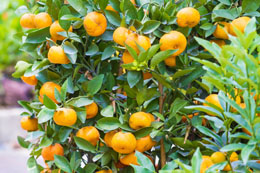Want to plant a fruit tree in your garden? Try a satsuma tree. You can enjoy its fruits AND it's pretty to look at too! Read on for some great information on it and how you can plant one.

When you look at it, the first thing that'll come to your mind is glazed orange candy on a blanket of dark grass! Yes that's exactly what a satsuma tree looks like. Wouldn't you love to have one of these decorating your garden? Read ahead for all the information you need.
What is a Satsuma Tree?
Given below is some general information on the satsuma tree.
- The satsuma tree is an evergreen tree native to Japan.
- It has dark green leaves and white flowers which have a refreshing fragrance.
- It flowers in spring.
- In spring, it bears a type of seedless mandarin (like oranges) which is easier to peel than the others.
- These citrus fruits develop and are ready to be picked by the onset of winter.
- It is a hardy tree that can tolerate cold climates and temperature below 15 degrees F or even lower.
- The satsuma tree grows well in full sun. At least 10 hours a day of bright sunlight is required if you want a good harvest of fruits.
- The tree bears fruit for many years.
- It grows up to an average height of 18-20 feet.
Caring for a Satsuma Tree
How to Plant It
- Get a satsuma sapling from the nursery.
- Transfer the sapling from its container (usually, 5 gallon) into a gallon container that is filled with well-drained potting soil and fertilizer.
- Keep the sapling in this container till it is ready to be planted.
- Dig a hole in an area that is exposed to sunlight for at least 8 hours.
- The hole should be at least thrice as wide as the root ball of the sapling, because the tree's roots will branch out.
- Take your sapling and place it in the hole.
- Fill the hole with soil and fertilize it.
- Initially, water the plant regularly. But you can increase the intervals between watering, as the tree grows.
- Make a border around the tree with soil to ensure that the water remains in the tree area.
- Don't over water the tree as this could cause some serious damage. Texas Cooperative Extension horticulturist, Dr. Steve George of Dallas, says, "For every satsuma that dies from drought, you'll kill 200 from overwatering." So beware.
- If you're wondering when to plant a satsuma tree, here's your answer; wait until the winter has passed because a satsuma sapling could freeze in frost. This way, the tree will be ready with fresh blossoms and juicy fruits which are a rich source of vitamin C, by the next year.
- In case of indoor container planting, you don't need to worry about when to plant it. Just make sure you maintain a reasonable temperature.
How to Prune It
- Prune this tree in spring so that it can heal before the winter arrives. Winter slows down the healing process.
- Use a pair of sharp gardening shears to prune the tree.
- First prune off the most obviously dried and damaged branches.
- To maintain a particular height and shape of the tree, prune the upper branches in the shape that you desire and up to the level that you want.
- When you are cutting, cut at the base of the branch (branch collar).
- If the branch is too large, you should use 3 cuts to do it.
Disease Control
- Citrus Canker: It is one of the most infectious bacterial citrus fruit diseases. It spreads through the medium of wind and rain. Newly planted saplings are more susceptible to this disease which causes spots on the foliage and weak twigs. Lesions on fruit and dieback of twigs is another symptom. Control this disease by treating the plants with copper-based sprays.
- Greasy Spot: In this disease, the leaves of the tree begin to fall of prematurely. It is a fungal infection which gives the tree yellow spots on the underside of the leaves. The fungus becomes dark and greasy, eventually causing the affected leaves to fall off. To control this disease, remove any old leaves of the previous season from around the tree, as this is the breeding ground for the fungus. Regular oil spray treatment also works.
These were some tips to care for this pretty tree. Hope this article has given you all the information you need on the satsuma tree. Go get one today. Take good care of this lovely tree and you can reap its delicious fruits for your entire family.






 When you look at it, the first thing that'll come to your mind is glazed orange candy on a blanket of dark grass! Yes that's exactly what a satsuma tree looks like. Wouldn't you love to have one of these decorating your garden? Read ahead for all the information you need.
When you look at it, the first thing that'll come to your mind is glazed orange candy on a blanket of dark grass! Yes that's exactly what a satsuma tree looks like. Wouldn't you love to have one of these decorating your garden? Read ahead for all the information you need.